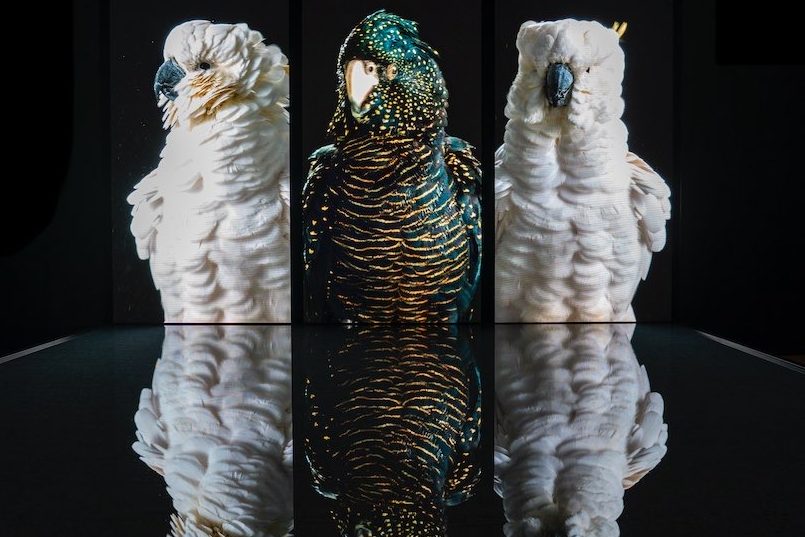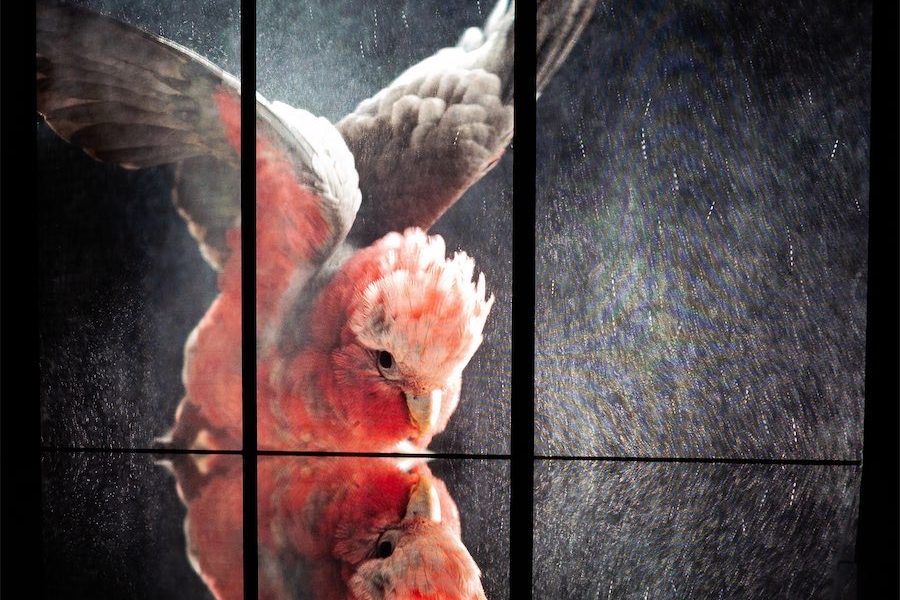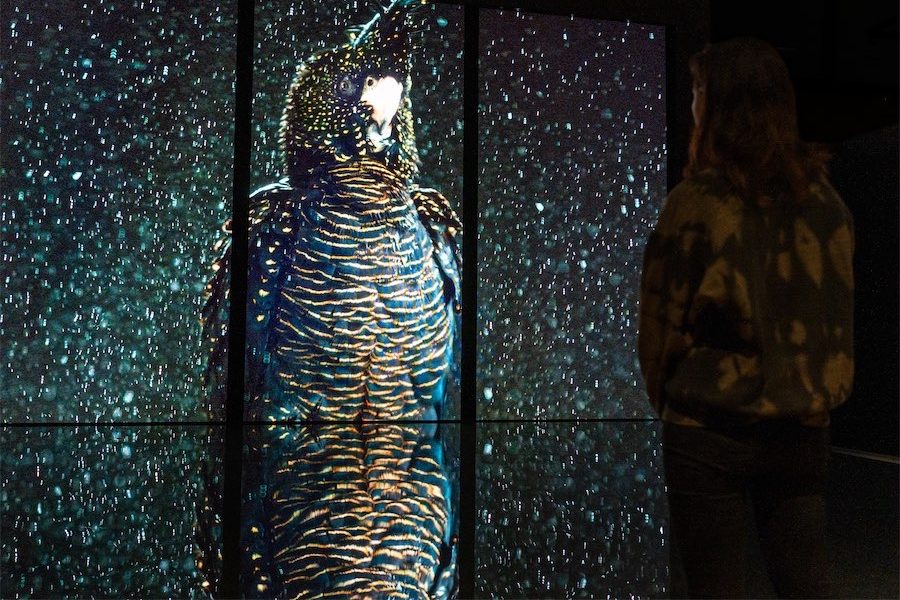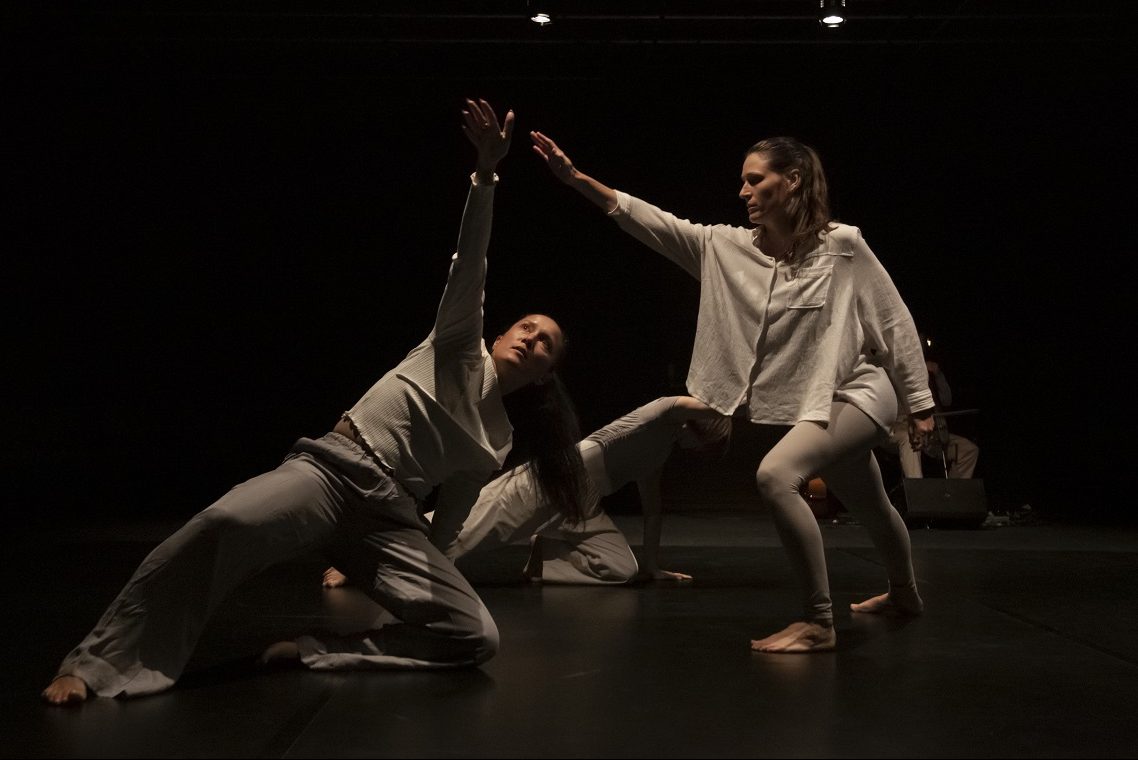
Immersion is the name of the game in the arts these days as entrepreneurs, curators and national institutions scramble to attract an often indifferent public looking for something that will knock their socks off.
That’s how it was with Van Gogh Alive in the parliamentary triangle and Connection: Songlines from Australia’s First Peoples at the National Museum.
The National Film And Sound Archive has jumped on board with dramatic moving vision of the red-tailed black cockatoo, galah and sulphur-crested cockatoo rising, falling, shaking and playing with water, seen on huge screens in an audiovisual experience called Temple – “because it’s like a temple of nature. You can feel the awe,” the artists say.
When I caught up with photographic artist Leila Jeffreys and film director Melvin J Montalban, they tell me it was initially shown outdoors near Circular Quay for Vivid in 2022, but had nothing of the feeling of the present show, now remounted in the main hall of the NFSA, but in darkness.
There is a central triptych screen (three, four metre-high screens joined) inside, but the slow-motion visuals also play across triple screens placed on each side of the entry/exit point. The installation also includes a shallow pool of water in front of the central screen.
The Vivid installation also had tall screens and a large reflective pool, but it was outdoors in a park opposite Customs House, hardly peaceful and serene.
“It’s totally different at the NFSA, set in a dedicated room in an Art Deco gallery with soaring ceilings and beautiful detail,” Montalban says. “It allows the artwork to be experienced in darkness and we can really connect in a way we couldn’t on outdoor screens.”

There is also sound, scored by Sydney composer Jackson Milas.
“We basically knew the whole idea,” Jeffreys says. “We wanted to create an emotional connection to the work, so we discussed what was the main sound in the birds’ environment and we agreed that the violin would be perfect.”
They engaged top violinist Véronique Serret, then Milas went away and started composing.
“Véronique got to play whatever she wanted,” Montalban says.
“In the end, the score is a single violin but layered in many ways, abstracted.”
That too, he believes, sounds better in the NFSA.
“The hardwood floor and the cavernous space amplifies it, whereas outdoors we had to be conscious of the needs of residents.”
Jeffreys stresses that they wanted the work to be immersive so viewers could get right into it and meditate, “so you can really take in every detail of the birds’ movements… the building becomes a kind of capsule for it.”
According to Jeffreys, they were approached around a year ago by Chris Mercer, head of Programs and Place at the NFSA, who was looking for something quite different to follow the previous show, Australians in Hollywood.
She’s the bird expert of the pair, and says: “I’ve been working with birds for 15 years and I’ve got a good understanding of birds, but studio portraits are different, so when you see the movie, you think, oh my god it’s so beautiful.”

But Montalban, as their filmmaker, wanted to show people something they hadn’t seen before.
Slow motion was the answer.
“By filming at 1000 frames a second, incredibly slow motion, you get to say something so magical, but normal too. I think we knew instantly how beautiful it would be,” he says.
Jeffreys consulted the “lovely guys” at the bird sanctuary, Feathered Friends in western Sydney, about how they could work with birds in the studio but it was Montalban who initially thought of the shimmering water mist that features so prominently.
“Melvin took very great care of them to make them comfortable,” Jeffreys says.
“The most exciting thing was discovering how they love to play in the water, to bathe,” says Montalban.
“It was a magical discovery for us, this choice to use mist… they play with it and when it’s filmed it becomes starry fields or snow…you ask, is that water or is it mist?
“And the reflection pool brings in another element. In Sydney they had to have a fence around it.”
Jdeffreys says: “In nature when you see something grand like a waterfall you just get this feeling, and we wanted to try and bring into the artwork that same kind of energy.
“Luckily, if one of us has an idea, we layer on to it, it’s a wonderful experience of dreaming – and we both dream big.”
Temple, National Film and Sound Archive until June 30. Free entry.
Who can be trusted?
In a world of spin and confusion, there’s never been a more important time to support independent journalism in Canberra.
If you trust our work online and want to enforce the power of independent voices, I invite you to make a small contribution.
Every dollar of support is invested back into our journalism to help keep citynews.com.au strong and free.
Thank you,
Ian Meikle, editor



![Teacher Vanessa Jones has been living in Higgins since 2001, and while she loves the area, she says she is “fed up” with the neglectful ACT government.
The Higgins shops have been completely abandoned, says Vanessa, preventing the opportunity for residents to have a community-centred space to socialise.
They only received bins nine months ago, she says, and requests for a water station and repairs to the bus station have gone unanswered.
“It’s very, very slow,” says Vanessa.
“I asked for the zebra crossing on Fullagar [Crescent] to be repainted, and we had to wait about six or nine months.
“That’s just such a long time… we pay a lot of rates.”
Vanessa says assistance from the government only seems to go to communities with time-rich and assertive communities, leaving places such as Higgins, where the majority of households have both adults working full-time and English may not be the first language of the family, at an automatic disadvantage.
“If you’ve got two people working, paying a mortgage, raising two or three kids, they don’t have the time,” says Vanessa.
Vanessa says the lack of attention quieter places such as Higgins is receiving is starting to look a lot like favouritism.
Read the full article on our website citynews.com.au
#canberra #canberranews](https://citynews.com.au/wp-content/plugins/instagram-feed/img/placeholder.png)
Leave a Reply